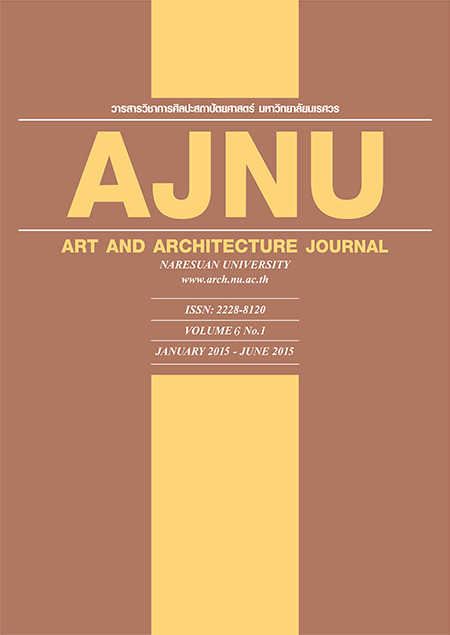การพัฒนาเกม 2 มิติ สำหรับฝึกทักษะการแยกสี ขนาด และรูปทรงเรขาคณิตของเด็ก ที่มีความบกพร่องทางสติปัญญาระดับกลาง
Main Article Content
Abstract
การวิจัยเรื่องการพัฒนาเกม 2 มิติ สำหรับฝึกทักษะการแยกสี ขนาด และรูปทรงเรขาคณิตของเด็กที่มีความบกพร่องทาง
สติปัญญาระดับกลาง มีวัตถุประสงค์ คือ 1) เพื่อพัฒนาเกม 2 มิติ สำหรับฝึกทักษะการแยกสี ขนาด และรูปทรงเรขาคณิตของเด็กที่มี
ความบกพร่องทางสติปัญญาระดับกลาง และ 2) เพื่อศึกษาผลการเรียนรู้การใช้เกม 2 มิติ สำหรับฝึกทักษะการแยกสี ขนาด และ
รูปทรงเรขาคณิตของเด็กที่มีความบกพร่องทางสติปัญญาระดับกลาง กลุ่มตัวอย่างเป็นเด็กนักเรียนโรงเรียนกาฬสินธุ์ปัญญานุกูล ที่มี
ความบกพร่องทางสติปัญญาระดับปานกลางจำนวน 10 คน ใช้วิธีการสุ่มแบบเจาะจง ไม่เป็นผู้พิการซ้ำซ้อนและสามารถใช้คอมพิวเตอร์
ได้เบื้องต้น เครื่องมือที่ใช้ในการวิจัย มีดังนี้ 1) เกม 2 มิติ สำหรับฝึกทักษะการแยกสี ขนาด และรูปทรงเรขาคณิตของเด็กที่มีความ
บกพร่องทางสติปัญญาระดับกลางที่ผู้วิจัยพัฒนา 2) แบบประเมินองค์ประกอบการออกแบบและคุณภาพเกม 2 มิติ สำหรับฝึกทักษะ
การแยกสี ขนาด และรูปทรงเรขาคณิต 3) แบบทดสอบทักษะในการแยกสี ขนาด และรูปทรงเรขาคณิตก่อนและหลังใช้เกม 2 มิติ และ
4) แบบสังเกตพฤติกรรมการเรียนรู้ของเด็กที่มีความบกพร่องทางสติปัญญาระดับกลาง ที่แสดงออกขณะเล่นเกม 2 มิติ ฝึกทักษะการ
แยกสี ขนาด และรูปทรงเรขาคณิต สถิติที่ใช้ในการวิเคราะห์ข้อมูล ได้แก่ ค่าเฉลี่ย ส่วนเบี่ยงเบนมาตรฐาน และการทดสอบที (t -
test)
ผลการศึกษาพบว่า
1. องค์ประกอบการออกแบบและคุณภาพเกม 2 มิติ สำหรับฝึกทักษะการแยกสี ขนาด รูปทรงเรขาคณิตของเด็กที่มีความ
บกพร่องทางสติปัญญาระดับกลาง ประเมินโดยผู้เชี่ยวชาญองค์ประกอบการออกแบบ 4 ด้าน คือ 1) ด้านการออกแบบส่วนนำเข้าเกม 2
มิติ 2) ด้านการออกแบบกิจกรรมส่งเสริมการเรียนรู้ในเกม 2 มิติ 3) ด้านการออกแบบหน้าจอเกม 2 มิติ และ 4) ด้านการออกแบบการ
ใช้งานเกม 2 มิติ โดยรวมพบว่า มีองค์ประกอบการออกแบบดีมากทั้ง 4 ด้าน ส่วนด้านคุณภาพของเกม 2 มิติ โดยรวมมีคุณภาพสูงมาก
2. ผลการเรียนรู้การใช้เกม 2 มิติ สำหรับฝึกทักษะการแยกสี ขนาด และรูปทรงเรขาคณิตของเด็กที่มีความบกพร่องทาง
สติปัญญาระดับกลาง หลังใช้เกม 2 มิติ พบว่า มีคะแนนทักษะสูงขึ้น อย่างมีนัยสำคัญทางสถิติที่ระดับ .05 โดยเด็กมีทักษะในการแยกสี
ได้ดีมาก รองลงมาแยกรูปทรงเรขาคณิตได้ดีและแยกขนาดได้พอใช้
3. พฤติกรรมการเรียนรู้ของเด็กที่มีความบกพร่องทางสติปัญญาระดับปานกลาง เมื่อใช้เกม 2 มิติสำหรับฝึกทักษะการแยกสี
ขนาดและรูปทรงเรขาคณิต โดยรวมทั้ง 3 ด้าน เด็กมีทักษะอยู่ในเกณฑ์ดี
นอกจากนี้เกม 2 มิติสำหรับฝึกทักษะการแยกสี ขนาด และรูปทรงเรขาคณิตที่ผู้วิจัยออกแบบและพัฒนาขึ้น เด็กให้ความสนใจ
ภาพที่ออกแบบเหมือนจริงมีมวลปริมาตร 3 มิติ การนำภาพบุคคล หรือสิ่งของที่เด็กรู้จักมาใช้ในการออกแบบทำให้เกิดการเคลื่อนไหว
จะกระตุ้นความสนใจเด็กได้ดี ทำให้เด็กมีปฏิสัมพันธ์ขณะเล่นเกม การจัดวางองค์ประกอบควรเป็นระเบียบ สีที่ใช้ในการออกแบบควร
เป็นสีที่สดใสสะอาดตา ภายในเกมมีเนื้อหาสอดคล้องกับวัตถุประสงค์ เหมาะสมกับผู้เรียน เมื่อเด็กเล่นเกมผ่านแต่ละด่านมีการเสริมแรง
ด้วยการให้ดาว หรือสิ่งที่เด็กชอบ ส่งเสริมให้เด็กมีความมุ่งมั่นมีสมาธิในการเรียนรู้ เกมมีความหลากหลายน่าสนใจ สามารถนำไป
เผยแพร่เป็นสื่อส่งเสริมด้านฝึกทักษะการแยกสี ขนาด และรูปทรงเรขาคณิตของเด็กที่มีความบกพร่องทางสติปัญญาระดับกลางได้
This study was to purposively development 2D animation games to develop the skill in classifying colors,
sizes, and geometric forms to help children with moderate mental Retardation , and to explore the children’s
learning outcome after trying out the 2d animation games. The sample group was 10 students with moderate
mental retardation from Kalasin Panyanukul School. These samples were selected by a purposive sampling
method. Particularly, the students were not redundantly disabled and able to use basic computer skills. The
research tools in this study were: 1) the 2D animation game developed by the researchers to help the children
develop their skill in classifying colors, sizes, and geometric forms; 2) the evaluation from on the designing
features and quality of the 2D animation game; 3) the skill test on classifying colors, sizes, and geometric forms
provided after the students trying out the 2D animation game; and 4) the observation form the student’s learning
behavior while playing the game. The data was analyzed and resulted as mean, standard deviation, and T-test
score.
The study outcome was found as follows.
1. In term of the designing features and quality, the experts evaluated and affirmed that the 2D animation
game fully contains all desired features covering four dimensions. Considering each dimension, it was found that
1) the game’s introduction was designed with quality elements; 2) the learning activities were perfectly designed
with high quality elements; 3) the game’s display was perfectly designed with high quality elements; 4) the
game’s function was perfectly designed with high quality elements. For these reasons, the 2D animation game is
totally a very high quality instructional media.
2.The student’s learning outcome after trying out the 2D animation game indicated that the students
demonstrated higher score on their skill test, in which the mostly developed skill was color classifying followed
by the geometric forms and sizes. Comparing the student’s learning outcome before and after using the 2D
animation game, the students developed a better outcome with a statistical significance of <.05, as expected in
the hypothesis.
3. Based on the behavioral observation, the students with moderate mental retardation became more
skillful in classifying colors, sizes, and geometric forms, after learning through the 2D animation.
In addition, the 2D animation game that had been developed by the researchers effectively encouraged
the children with moderate mental retardation to learn more with its attractive 3D features. Designing the game
with photos of people or places that the student were familiar with motivated them to be more interested in
and interact more with the game. All features were delicately designed and the used colors were clean and
lively. The game’s content fully followed the learning objectives and was appropriate for the children. Each time
the student completed a mission, they were given a star which encourage them to do the next missions so that
they became more determined and concentrated in learning. These games also contained a variety of attractive
features so that it was affirmed as a n effective instructional media for facilitating the children with moderate
mental retardation to be more skillful in classifying colors, sizes, and geometric forms.


